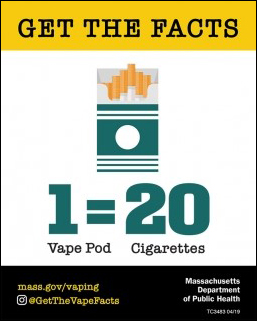How do I quit?
-
Talk to someone you trust. Talk to:
- Kristen Strelis, our District-wide Substance Abuse Prevention and Intervention Specialist. (Ms. Strelis can see students during office hours on Wednesdays from 8:30a.m.–11:00a.m. by appointment or students can see her without an appointment on Wednesdays from 11:00a.m.–12:30p.m.)
- Students at K-12 Schools also talk to their School Guidance Counselor.
- Somerville High School students can also speak confidentially with a High School Counselor, High School Mental Health professional, or School Nurse about concerns.
- Talk to someone at The National Drug Helpline. They offer 24/7 help to those struggling with addiction. http://drughelpline.org/ or call 1-844-289-0879
- Get started with a phone app. Smoke-free Apps is a platform that provides 24/7 support and information via a phone app. The QuitGuide is a free app that helps you understand your smoking patterns. https://smokefree.gov/tools-tips/apps
- Connect with other teens. Teen and Youth addiction recovery program, SMART Recovery provides tools and resources. https://www.smartrecovery.org/teens/
Learn the Basics about Vaping and e-cigarettes
- Watch the 2-minute video Vaping: The New Look of Nicotine Addiction from the Massachusetts Department of Public Health about vaping and the tobacco industry.
- Vaping is done through e-cigarettes. E-cigarettes are battery-powered smoking devices. They have cartridges filled with a liquid that usually contains nicotine, flavorings, and chemicals. The liquid is heated into a vapor, which the person inhales. That's why using e-cigarettes is called "vaping."
- The cartridges filled with liquid are called pods. Pods contain nicotine and are put into the top of a juul or other e-cigarette for smoking. Each e-cigarette pod contains 5% nicotine, which is equivalent to 20 cigarettes.
- Many e-cigarette pods are manufactured in fruity flavors to appeal to young people. Consequently, it is illegal to sell flavored e-cigarette pods in Massachusetts.
- According to focus groups at Somerville High School, vaping tends to happen with friends and often happens in bathrooms.

What are the health effects of vaping?
- E-cigarettes containing tobacco contain nicotine. We know that nicotine can cause cancer and disrupt brain development.
- Recently, e-cigarettes have been linked to thousands of cases of serious lung illnesses and even deaths across the United States. While we don't know exactly why e-cigarettes are causing these illness and deaths, e-cigarette pods often contain harmful chemicals like antifreeze and nitrosamines, which have been linked to lung cancer. Even breathing secondhand smoke from e-cigartettes can be harmful for the lungs.
- Because e-cigarettes contain nicotine, there are worries that vaping can be addictive for both youth and adults. Nicotine use can lead to issues with impulse control and mood.
- In some cases, e-cigarette devices have exploded and caused burns and fires.
- Some people are are also now smoking/vaping marijuana, herbs, waxes and oils, which can lead to further issues for brain development in young people.
- E-cigarettes have been marketed as a safe way to stop smoking traditional cigarettes; however, the U.S. Food and Drug Administration (FDA) has not approved e-cigarettes for this purpose because the long-term health effects to users and bystanders are still unknown. This means there are no standard regulations determining which chemical compounds can be put into an e-cigarette, so consumers may have no idea what they are inhaling into their bodies!

E-Cigarettes and Advertising
- E-cigarette advertising and marketing are not regulated like other tobacco products.
- E-cigarette companies are allowed to advertise on television and use celebrity endorsements and cartoons to seem appealing to younger generations.
- Big Tobacco has been targeting younger generations by creating colorful flavors. Juul Labs recently faced a trial for its campaigns that included young models and flavor names that were enticing.
- E-cigarettes have been marketed through social media accounts directly to teens and young people. Many social media "influencers" have promoted e-cigarettes through their posts.
Read up on Vaping
- Know the Risks: E-Cigarettes & Young People
- Know the Real Cost of Vaping. Information and games to learn how vaping affects health.
- Teens and E-cigarettes | National Institute on Drug Abuse. Statistics and trends around teen e-cigarette use.
- Vapes and Cigarettes
Share the Knowledge
How can Somerville Students help each other?
- Get informed by watching the Somerville Cares About Prevention (SCAP): Anti-Vaping Public Service Announcement developed by Somerville Youth with staff from the Health and Human Services Department.
- Join the Somerville Positive Forces (SPF) chapter of the 84.org, a way for students to organize together to stop vaping and to promote awareness and education.
- Help student-members of Somerville Positive Forces organize the annual Kick Butts Day. It is a national day of activism that empowers youth to stand out, speak up, and seize control against Big Tobacco.

Resources for the classroom
Tobacco Prevention Toolkit from Stanford Medicine: Detailed resources with facts and science about why e-cigarettes are harmful. It contains powerpoints, kahoots, and take home assignments to share. Science educators may want to look at lesson 3 and language arts teachers may want to check out lesson 6, which discusses Juul Marketing Strategies.

